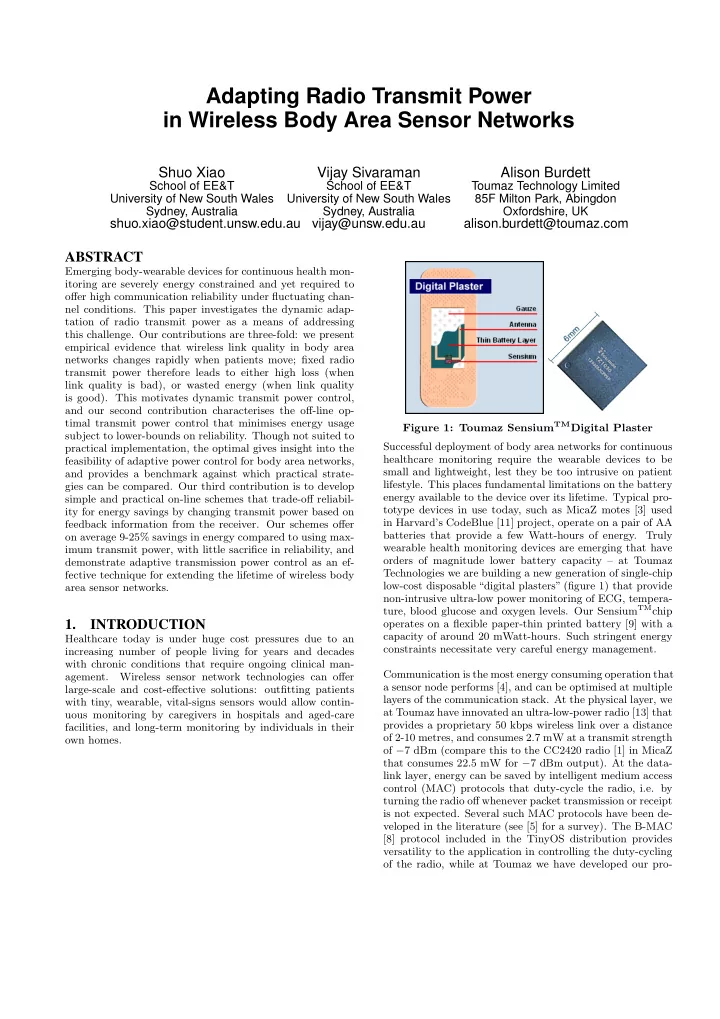

Adapting Radio Transmit Power in Wireless Body Area Sensor Networks Shuo Xiao Vijay Sivaraman Alison Burdett School of EE&T School of EE&T Toumaz Technology Limited University of New South Wales University of New South Wales 85F Milton Park, Abingdon Sydney, Australia Sydney, Australia Oxfordshire, UK shuo.xiao@student.unsw.edu.au vijay@unsw.edu.au alison.burdett@toumaz.com ABSTRACT Emerging body-wearable devices for continuous health mon- itoring are severely energy constrained and yet required to offer high communication reliability under fluctuating chan- nel conditions. This paper investigates the dynamic adap- tation of radio transmit power as a means of addressing this challenge. Our contributions are three-fold: we present empirical evidence that wireless link quality in body area networks changes rapidly when patients move; fixed radio transmit power therefore leads to either high loss (when link quality is bad), or wasted energy (when link quality is good). This motivates dynamic transmit power control, and our second contribution characterises the off-line op- timal transmit power control that minimises energy usage Figure 1: Toumaz Sensium TM Digital Plaster subject to lower-bounds on reliability. Though not suited to Successful deployment of body area networks for continuous practical implementation, the optimal gives insight into the healthcare monitoring require the wearable devices to be feasibility of adaptive power control for body area networks, small and lightweight, lest they be too intrusive on patient and provides a benchmark against which practical strate- lifestyle. This places fundamental limitations on the battery gies can be compared. Our third contribution is to develop energy available to the device over its lifetime. Typical pro- simple and practical on-line schemes that trade-off reliabil- totype devices in use today, such as MicaZ motes [3] used ity for energy savings by changing transmit power based on in Harvard’s CodeBlue [11] project, operate on a pair of AA feedback information from the receiver. Our schemes offer batteries that provide a few Watt-hours of energy. Truly on average 9-25% savings in energy compared to using max- wearable health monitoring devices are emerging that have imum transmit power, with little sacrifice in reliability, and orders of magnitude lower battery capacity – at Toumaz demonstrate adaptive transmission power control as an ef- Technologies we are building a new generation of single-chip fective technique for extending the lifetime of wireless body low-cost disposable “digital plasters” (figure 1) that provide area sensor networks. non-intrusive ultra-low power monitoring of ECG, tempera- ture, blood glucose and oxygen levels. Our Sensium TM chip 1. INTRODUCTION operates on a flexible paper-thin printed battery [9] with a capacity of around 20 mWatt-hours. Such stringent energy Healthcare today is under huge cost pressures due to an constraints necessitate very careful energy management. increasing number of people living for years and decades with chronic conditions that require ongoing clinical man- Communication is the most energy consuming operation that agement. Wireless sensor network technologies can offer a sensor node performs [4], and can be optimised at multiple large-scale and cost-effective solutions: outfitting patients layers of the communication stack. At the physical layer, we with tiny, wearable, vital-signs sensors would allow contin- at Toumaz have innovated an ultra-low-power radio [13] that uous monitoring by caregivers in hospitals and aged-care provides a proprietary 50 kbps wireless link over a distance facilities, and long-term monitoring by individuals in their of 2-10 metres, and consumes 2 . 7 mW at a transmit strength own homes. of − 7 dBm (compare this to the CC2420 radio [1] in MicaZ that consumes 22 . 5 mW for − 7 dBm output). At the data- link layer, energy can be saved by intelligent medium access control (MAC) protocols that duty-cycle the radio, i.e. by turning the radio off whenever packet transmission or receipt is not expected. Several such MAC protocols have been de- veloped in the literature (see [5] for a survey). The B-MAC [8] protocol included in the TinyOS distribution provides versatility to the application in controlling the duty-cycling of the radio, while at Toumaz we have developed our pro-
Recommend
More recommend